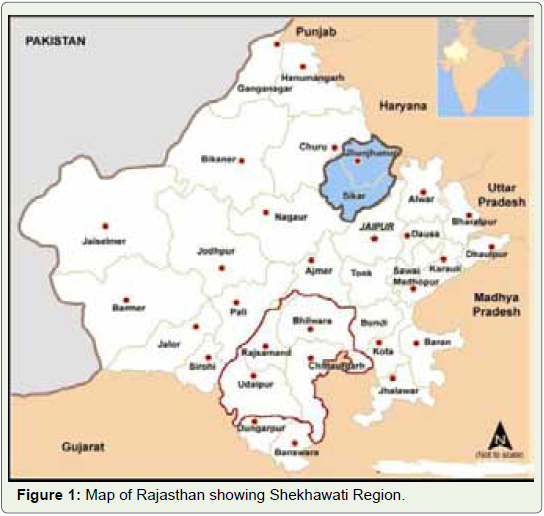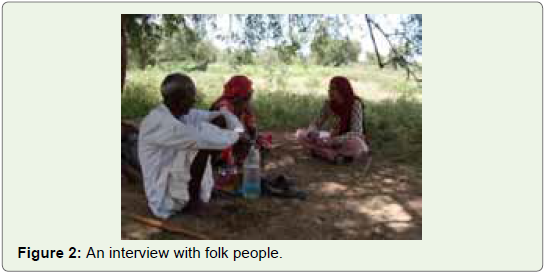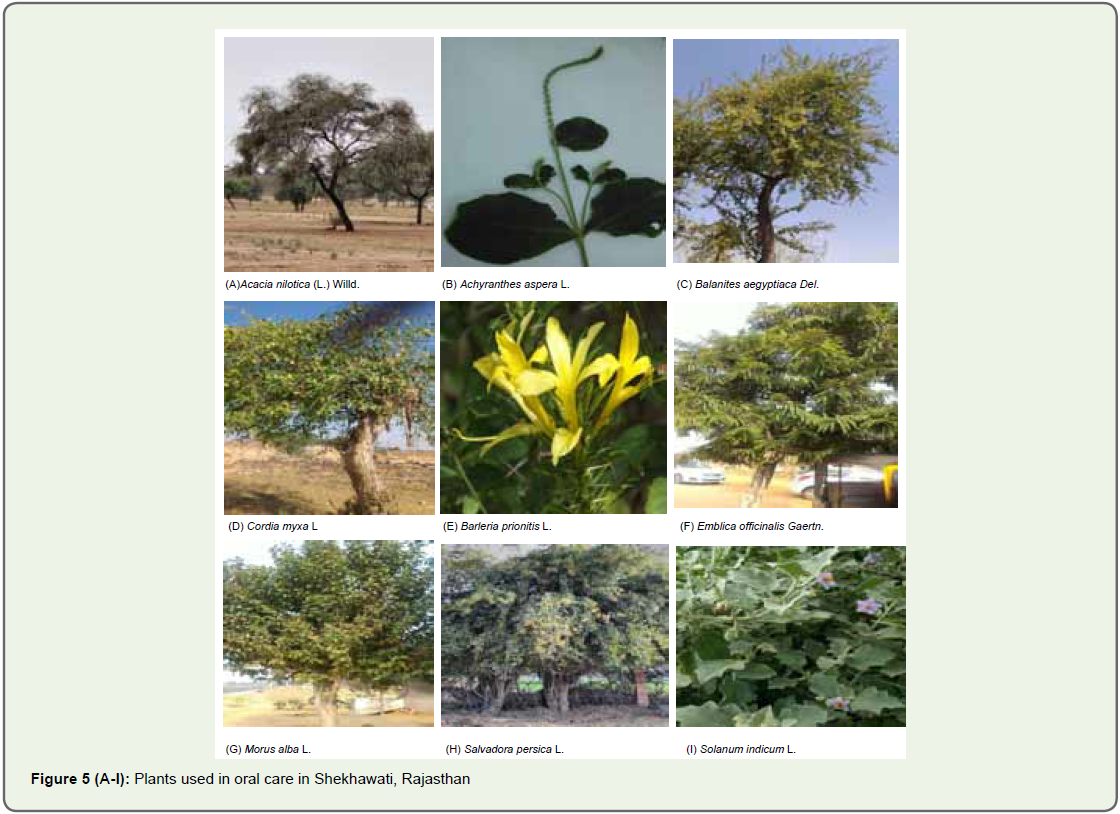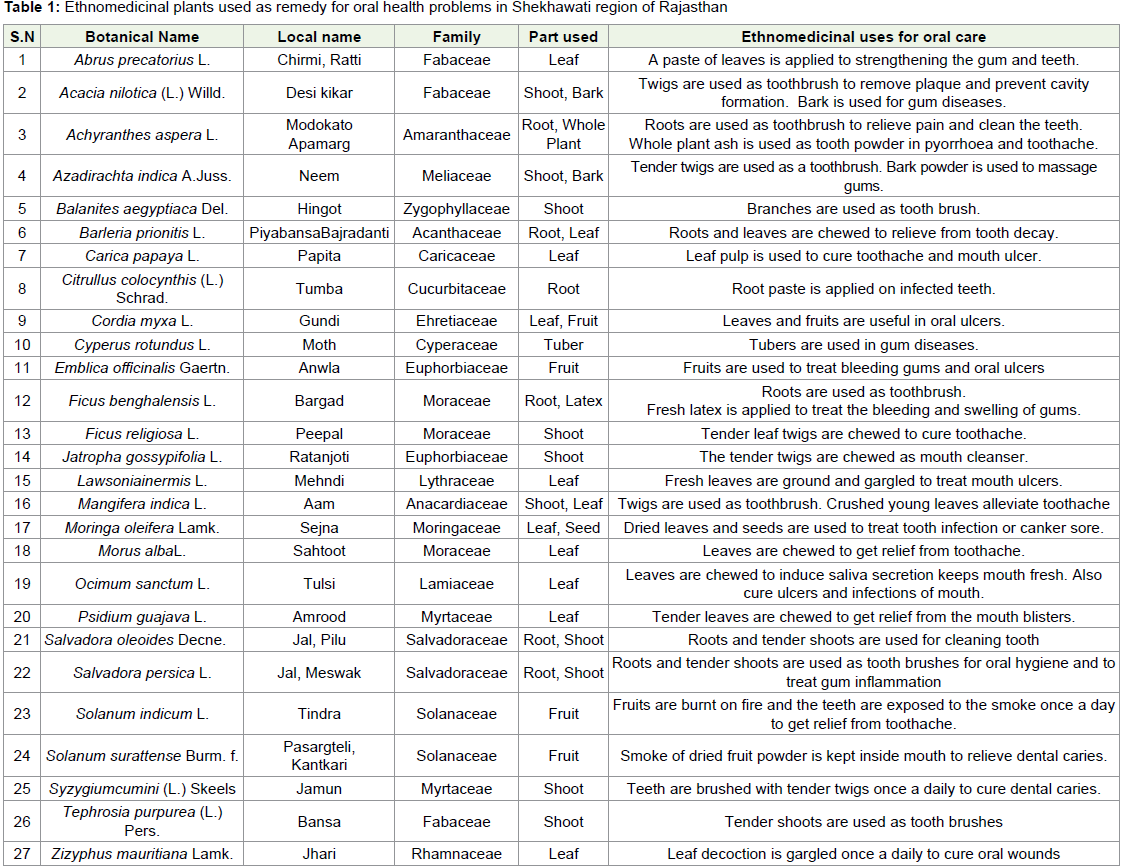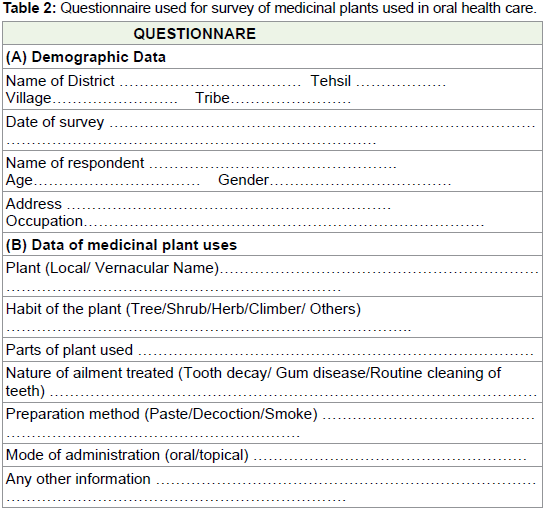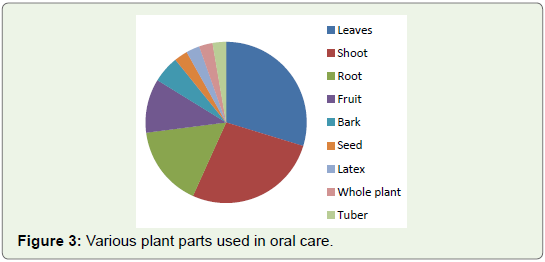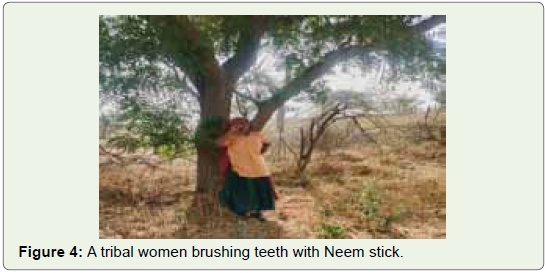Research Article
Ethnomedicinal Plants used for Oral Health Care in Shekhawati Region of Rajasthan, India
Manju C*
Department of Botany, Govt. College, Jhunjhunu, India
*Corresponding author: Manju C, Department of Botany, Govt. College, Jhunjhunu, Rajasthan, India, Email:
me.manjuchaudhary@gmail.com
Copyright: © Manju C. 2021. This is an open access article distributed under the Creative Commons Attribution License, which
permits unrestricted use, distribution, and reproduction in any medium, provided the original work is properly cited.
Article Information: Submission: 24/05/2021; Accepted: 18/05/2021; Published: 22/06/2021
Abstract
Oral hygiene is essential to general health and quality of life. Medicinal plants are widely used by traditional practitioners in the maintenance of oral
hygiene. The primary objective of this study is to present a database on indigenous knowledge on medicinal plants used for oral care among the local
traditional healers of Shekhawati region of Rajasthan. A survey was carried out during the period 2019-20 and information regarding the different types of
plants used in oral care, mode of administration was collected through interactions with rural and traditional healers of the region. The study enumerated 27
plant species belonging to 24 genera and 19 families. The various plant parts were twigs, roots, leaves, seeds, latex and sometimes whole plants used in oral
healthcare. In spite of the modernization process, the rural folk and the tribal of this region still hold on their traditional faith and depend on indigenous plants
for their various ailments but young generation are reluctant for this wealth of knowledge. Therefore, it is necessary to preserve this indigenous knowledge
by proper documentation and to record information for future investigation and potential development of new drugs. The study emphasizes the need for the
clinical evaluation of these plant species for their therapeutic use.
Keywords
Dental caries; Oral disease; Peridontal; Pyorrhoea; Shekhawati
Introduction
Oral hygiene is vital to an individual’s overall health and wellbeing.
Oral diseases are one of the major public health problems
around the world. The most prevalent and consequential oral diseases
globally are dental caries, periodontal diseases, oral and pharyngeal
cancers [1-2]. The Global Burden of Disease Study 2017 estimated
that oral diseases affect nearly 3.5 billion people worldwide, with
caries of permanent teeth being the most common condition [3]
Scientific reports in the past decade signal an alarming increase
in the global prevalence of dental caries in children and adults,
primary and permanent teeth, as well as coronal and root surfaces.
Dental care and hygiene of oral cavity is an integral part of health
and when it is neglected, it results in different types of oral problems
[4]. Oral disorders significantly affected person by causing pain and
discomfort and thereby affecting quality of life. Dental calamities are
threats to the oral health and it influences individuals, society and increases personal expense of their treatment. Dental diseases are
mainly caused by bacterial infections, food habits and ignorance in
life style [5].
In India, medicinal plants are used from thousands of years as
traditional medicine to maintain oral health and hygiene. The use of
Azadirachta indica, Acacia nilotica, Salvadora persica in dental health
care has been reported by several workers [6-8]. Different parts of
plants are used for periodontal diseases, cleaning teeth, preventing
dental caries or mucosal diseases. Various studies have shown that
rural folk in different parts of India use stem, leaves and fibers of
some plants for dental care like toothache, tooth decay, pyorrhoea,
foul smell and as tooth brush for cleaning teeth [9].
In Rajasthan, the folk and rural people depend on plant resources
for their primary oral health care needs. The common traditional
practice is the use of plant parts specially tender twigs or chewing sticks of Azadirachta indica and Acacia nilotica instead of plastic bristle
brushes to massage the gums and clean the teeth [10]. Though,
several ethnomedicinal studies have been carried out in different parts
of Rajasthan but the documentation of traditional medicine for the
treatment of oral diseases has never been done in a systematic manner
in Shekhawati region of Rajasthan. Therefore, the present study was
planned to explore and document the diversity of therapeutic flora
and the remedies used traditionally in treating oral ailments by the
folk people of this area.
Materials and Methods
Rajasthan is well known for its biodiversity richness of diverse
cultural mosaic. The state is located in the North western part of India
(Figure 1). It can be segregated in several specific regions. Shekhawati
is one such significant region, located in the north-east part of
Rajasthan. It is a historical region and covers Aravalli hilly region,
semi-arid transitional plains and desert area. The Shekhawati region
consists of mainly two districts Sikar (7,742 km) and Jhunjhunu
(5,928 km), which are situated between 27°21’ to 28°12’ north latitude
and 74°44’ to 75°25’ east longitudes respectively. Leaving a few hilly
spot like Lohargal, Harsh←nath, Khetri, Babai, Manasa Mata and
Shakambhari, the region is largely semi-arid or arid. The climate of
this area is harsh and extreme. Scorching hot summers to chilling
colds is the specialty of this region. Temperature reaches at 48-500 C
during the summer season and the mercury falls up to 40 C during
the winter. Annual rainfall is 23 inches falling largely in the months
of July-October. Apart from monsoon season, relative humidity is
terribly low and categorizing the climate as hot dry. Dust storms and
sandstorms are very common in this area.
An ethnomedicinal survey was conducted in Shekhawati
region of Rajasthan during 2019-20 to document the utilization of
indigenous plants in oral health and treating tooth and gum disorders.
The Sikar and Jhunjhunu districts are inhabited by different tribes
Gurjar, Meena, Rebari, Nat, Sansi, Banwariya, Kalbeliya etc. The
interviews were conducted with tribal people, Ayurvedic vaidyas and
knowledgeable individuals, ranging in age between 25 and 70 years
old. The healers were chosen randomly among those living in the
different villages of Shekhawati region. Tribal and folk people were
asked for various traditional uses of plant in dental care (2).
The conversations were performed in the local “marwari” language
and the information was directly translated and written in English. A
questionnaire was prepared before the survey of the study area (Table 2). While collecting data special care was taken to select remote
areas, which were inaccessible to medical institute and where use
of such traditional plant as medicine has been continuing till date.
The information recorded during the survey included the names and
ages of the informants, local names of utilized plants, plant parts
used, mode of administration and ailments treated. The gathered
data was verified by repeated queries with different local herbalists,
more specifically, the vaidyas and hakims. The collected data are
arranged alphabetically of their scientific names followed by local
name, family, parts used, medicinal use and mode of preparation and
administration. The plants used in oral healthcare are enumerated in
Table 1. Photographs of some plants reported from the study area are
shown in Figure 5 (A-I).
Table 1: Ethnomedicinal plants used as remedy for oral health problems in Shekhawati region of Rajasthan.
Results and Discussion
Nature has gifted Shekhawati region of Rajasthan with rich
diversity of medicinal plants. The traditional healers of this region are
having a commendable knowledge of the medicinal value of plants
those grow around them [11]. The present investigation comprises
27 plant species belonging to 24 genera and 19 families which are
traditionally used for oral health and hygiene by local inhabitants of
this area. For each species scientific name, family, local name, part
used, method of preparation, administration and ailment treatment
has been provided. Fabaceae and Moraceae were the most commonly
used family for oral health care. The most commonly utilized part of
the plant was leaves (30%) and shoot (27%) followed by roots(16%),
fruits (11%), bark(5%), latex (3%), seed (3%) and whole plant(3%) are
used in the form of paste, juice, latex, powder and smoke (Figure 3).
The present study reveals that the rural tribal people are well versed
with the nature and natural resources around them. These people in
order to get rid of various oral problems like dental caries, tooth decay
and pyorrhea depend on plant products. It was observed during the
survey, that the people still prefer chewing sticks of various plants
in maintaining oral hygiene. Generally, the fresh tender sticks locally
known as datun are widely used for brushing the teeth. In villages
across Shekhawati region it was a common site to see people chewing
a stick of Azadirachta indica or Neem datum (Figure 4), which turns
into a brush like stick that works as natural floss. Generally, thin and
flexible twigs are used. One end of these sticks is chewed until the
twig shreds into bristles which was then used to clean the teeth and
massage the gums. Chewing sticks of Acacia nilotica (babool) are used
to prevent gingivitis. Roots and tender twigs of Salvadora oleoides
and S. persica are also used as chewing sticks. S. persica is commonly
known as Miswak tree and have been used for centuries to improve
dental health and to promote oral hygiene. Its importance has been
mentioned in the Holy Quran. The World Health Organization has
also recommended and encouraged the use of miswak as an effective tool for oral hygiene [12].Young stem of Jatropha gossypifolia is used
as toothbrush to heal bleeding gums and gum boils. Leaves of Abrus
pecatorius, Cordia myxa, Mangifera indica and Psidium guajava are
chewed and decoction is applied in treating oral ailments. Roots,
bark, fruits and seeds are the other parts of plants being exploited
for oral health care. Achyranthes aspera, Barleria prionitis, Tephrosia
prurpurea are the other important plants used by the local people
for cleaning the teeth. The inhalation of smoke of fruits of Solanum
indicum and Solanum surattense kills the germs.
The use of medicinal plants has a long history in dental practice, and they have long been used worldwide [13-14]. The studies
conducted in different parts of India and Rajasthan also support
the findings of the present work [10,15-18]. Some of the medicinal
plants reported during the present study were reported for biological
activities and bioactive constituents responsible for their therapeutic
properties [19-20] which justify and validate the usages of these
species for medicinal purposes in the study area.
Conclusion
Oral health and general health are closely related and should be
considered holistically. Information gathered from the Shekhawati,
Rajasthan indicates that rural and tribal people of this area possess
good knowledge of herbal plants and still rely on traditional
indigenous medicines to treat dental caries and oral health problems.
Due to lack of interest among the younger generation there is a
possibility of losing this wealth of knowledge in the near future.
Plant-based traditional knowledge has become a recognized tool in
search for new sources of drug. The main advantages of using herbal
medicine are easy availability, cost-effectiveness, increased time
period and low toxicity. The information generated from the present study needs to be evaluated for proper biochemical analysis, level of
toxicity, phytochemical investigation, extraction and isolation along
with few clinical trials for their therapeutic use. Hence the study
emphasizes that these herbal medicines can offer a platform for
further research in dentistry.
Acknowledgement
The author would like to express deep sense of gratitude to rural
and folk people of Shekhawati region for sharing their knowledge on
herbal medicine.

